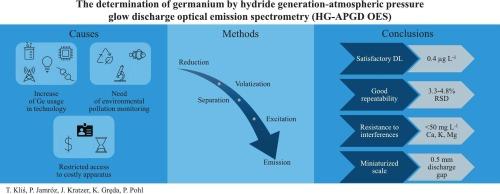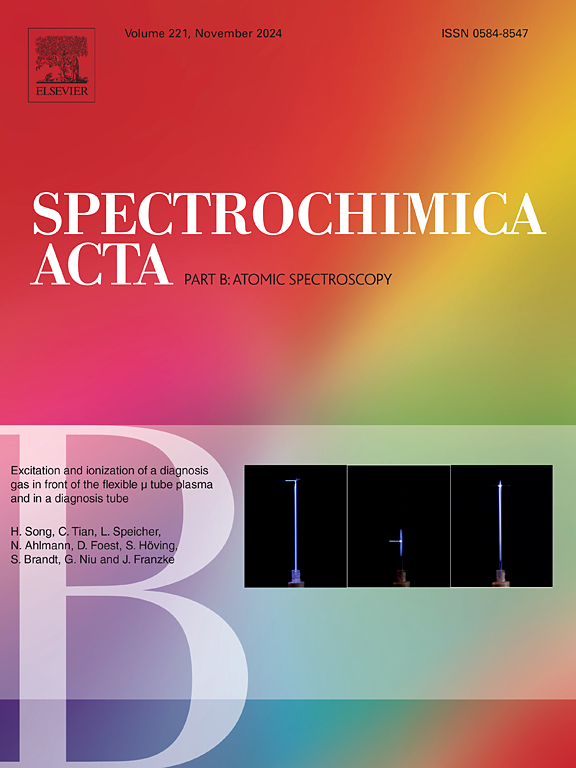The determination of germanium by hydride generation-atmospheric pressure glow discharge optical emission spectrometry (HG-APGD OES)
IF 3.8
2区 化学
Q1 SPECTROSCOPY
引用次数: 0
Abstract
Hydride generation (HG) was combined with an atmospheric pressure glow discharge (APGD) to determine Ge by optical emission spectrometry (OES) employing the Ge I 265.1 nm emission line. It was revealed that efficient atomization of GeH4 and excitation of Ge atoms require a microplasma with a higher energy density than other hydride-forming elements such as As, Sb, and Se. The operating conditions were optimized: discharge gap = 0.5 mm, cathode nozzle diameter = 0.7 mm, current = 45 mA, and carrier/discharge gas flow rate of 400 mL min−1 He. The measurement repeatability (n = 10) was within the range of 3.3–4.8 %, demonstrating the high stability of the novel HG-APGD system. The upper limit of linearity was 1000 μg L−1 Ge, and the method was resistant to interferences from easily ionized elements (Ca, K, Mg) at concentrations up to at least 100 mg L−1. The detection limit (DL) of Ge (0.4 μg L−1) was comparable to the values achieved using more expensive and sophisticated analytical instrumentation based on inductively coupled plasma (ICP) or microwave induced plasma (MIP) combined with OES. The trueness of HG-APGD OES was confirmed through a recovery test, which showed a high agreement between spiked and measured concentrations of Ge in the matrix of bottled, mineral-rich, river, and tap water samples. The Ge recoveries ranged from 99 % to 114 % at the spiking concentration of 10–20 μg L−1.

氢化物发生-大气压辉光放电光谱法测定锗
采用Ge I 265.1 nm发射谱线,将氢化物发生(HG)与常压辉光放电(APGD)相结合,采用光学发射光谱法(OES)测定Ge。结果表明,与as、Sb和Se等其他氢化物形成元素相比,GeH4的高效原子化和Ge原子的激发需要具有更高能量密度的微等离子体。优化的操作条件为:放电间隙为0.5 mm,阴极喷嘴直径为0.7 mm,电流为45 mA,载放气流量为400 mL min−1 He。测量重复性(n = 10)在3.3 ~ 4.8%范围内,证明了新型HG-APGD体系的高稳定性。该方法的线性上限为1000 μg L−1 Ge,且能抵抗浓度至少为100 Mg L−1的易电离元素(Ca, K, Mg)的干扰。Ge (0.4 μg L−1)的检出限(DL)可与电感耦合等离子体(ICP)或微波诱导等离子体(MIP)结合OES的昂贵精密分析仪器相媲美。HG-APGD OES的准确性通过回收率测试得到证实,在瓶装水、富含矿物质的水、河流和自来水样品的基质中,Ge的加标浓度和测量浓度高度一致。当峰浓度为10 ~ 20 μg L−1时,锗的回收率为99% ~ 114%。
本文章由计算机程序翻译,如有差异,请以英文原文为准。
求助全文
约1分钟内获得全文
求助全文
来源期刊
CiteScore
6.10
自引率
12.10%
发文量
173
审稿时长
81 days
期刊介绍:
Spectrochimica Acta Part B: Atomic Spectroscopy, is intended for the rapid publication of both original work and reviews in the following fields:
Atomic Emission (AES), Atomic Absorption (AAS) and Atomic Fluorescence (AFS) spectroscopy;
Mass Spectrometry (MS) for inorganic analysis covering Spark Source (SS-MS), Inductively Coupled Plasma (ICP-MS), Glow Discharge (GD-MS), and Secondary Ion Mass Spectrometry (SIMS).
Laser induced atomic spectroscopy for inorganic analysis, including non-linear optical laser spectroscopy, covering Laser Enhanced Ionization (LEI), Laser Induced Fluorescence (LIF), Resonance Ionization Spectroscopy (RIS) and Resonance Ionization Mass Spectrometry (RIMS); Laser Induced Breakdown Spectroscopy (LIBS); Cavity Ringdown Spectroscopy (CRDS), Laser Ablation Inductively Coupled Plasma Atomic Emission Spectroscopy (LA-ICP-AES) and Laser Ablation Inductively Coupled Plasma Mass Spectrometry (LA-ICP-MS).
X-ray spectrometry, X-ray Optics and Microanalysis, including X-ray fluorescence spectrometry (XRF) and related techniques, in particular Total-reflection X-ray Fluorescence Spectrometry (TXRF), and Synchrotron Radiation-excited Total reflection XRF (SR-TXRF).
Manuscripts dealing with (i) fundamentals, (ii) methodology development, (iii)instrumentation, and (iv) applications, can be submitted for publication.

 求助内容:
求助内容: 应助结果提醒方式:
应助结果提醒方式:


